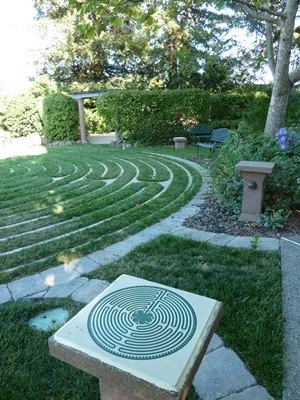BPC members have been considering whether to build a labyrinth in the green space in front of our church. To better understand labyrinth, and the many possibilities, we created this project page. It is intended for experiencing all the aspects of labyrinths, and discussing the possibilities for BPC. Feel free to use the comment area below to discuss.
There exist the following evolutionary stages of exploring labyrinths, in order of size, complexity, cost, and transitivity:
- The Finger Labyrinth
- The Masking Tape Labyrinth
- The Fabric Labyrinth (optional)
- The Earth Labyrinth
- The Plant Labyrinth
- The Journey Labyrinth
Anyone who wishes to explore labyrinths, we would recommend exploring each in order.
The Finger Labyrinth
Walking a labyrinth is a meditative practice. It's different than a maze, which is designed to be a puzzle, with decision points and dead ends. In a Labyrinth there is only one path, and it is the walking of the repetitive, geometric pattern that helps you to achieve a meditative state.
A similar effect can be achieved by “walking” a pattern on a sheet of paper by tracing it with your finger. It's a centering activity asking you to focus only on what comes next, staying in the moment.
Tracing a Finger LabYrinth
Classical Finger Labyrinth:
https://zdi1.zd-cms.com/cms/res/files/382/ClassicalLabyrinth.pdf
Chartres Finger Labyrinth:
https://zdi1.zd-cms.com/cms/res/files/382/ChartresLabyrinth.pdf
Drawing a Finger Labyrinth
Once you've experienced a labyrinth, a great way to become more familiar with their patterns and their geometry is to draw one yourself by hand.
https://labyrinthsociety.org/make-a-labyrinth
Group Project! The Masking Tape Labyrinth
Now that you've practicing using math to draw a labyrinth on a piece of paper, let's do the same on a real-life scale!
https://labyrinthsociety.org/make-a-labyrinth
Questionnaires
There is a questionnaire on the Labyrinth Society website for people to fill out after experiencing a labyrinth.
https://zdi1.zd-cms.com/cms/res/files/382/LabyrinthWalkQuestionnaireandInstructions.pdf
The latest compiled results of the survey are here:
https://zdi1.zd-cms.com/cms/res/files/382/Labyrinth-Walk-Questionnaire-Data-Composite-thru-3-2011.pdf
Commonly reported effects of Labyrinth walking:
https://zdi1.zd-cms.com/cms/res/files/382/Commonly-Reported-Effects-of-Labyrinth-Walking-Labyrinth-Pathways-July-2008-3.pdf
The Fabric Labyrinth
The fabric labyrinth is an easier way to experience multiple types of labyrinths before making a permanent choice of creating one. There are so many types that can be built.
PURCHASING a Portable Labyrinth
https://www.labyrinthcompany.com/
The Earth Labyrinth
Much like the Buddhist sand paintings, elaborate pictures and patterns created out of colored sand that are swept away after completion, creating a labyrinth need not be a permanent thing. You can create a labyrinth out of sand, rocks, loose bricks, paving stones, found objects, or anything you want. With a little math, a stick, and some string or rope (for circular, non-square patterns) you can place the objects in the same way as the masking tape to form a beautiful walking garden labyrinth.
The Types of Labyrinths
Try creating them all:
https://labyrinthsociety.org/labyrinth-types
The Planted Labyrinth
Once you've found a pattern that resonates with you, you can craft a more-permanent labyrinth, and a great way to do this is with plants. The tradition of the labyrinth is one tied to the earth and natural wonders. Being able to experience nature as you walk the labyrinth heightens your experience.
There are several ways to introduce plants to a labyrinth. They can surround the entrance, and the “goal” at the center of the labyrinth, to mark the starting and ending points. They can be added as stations along the path, geometrically laid out so that a person encounters and walks around them at regular intervals. You can build a labyrinth around existing trees and plants to encorporate the existing landscape.
You can even build the “walls” of the labyrinth out of plants. They could be just a couple inches high, small, flowering plants in a row, framing the path. They could be shrubbery to prevent you from stepping out of the path until you reach the goal. They could be taller than a person so that you cannot see where anywhere else in the labyrinth. This helps to keep people focused on the present, not looking forward to the next turn, or the path beside them, other people on the path, or the goal.
The Journey Labyrinth
The intent of a Journey Labyrinth is to craft an entire experience for the participants. At various points along the path they encounter objects, plants, trees, scripture passages, or other items intended to build on each previous item and enhance the experience. It's not unlike an exercise path at a park, or a maze of exhibits at a museum. The main difference that makes it a labyrinth is that there is one path to follow, and that path is defined by Sacred Geometry (https://labyrinthsociety.org/sacred-geometry).




